- Clone
- 3D10 (See other available formats)
- Regulatory Status
- RUO
- Other Names
- Klra8, Cmv1
- Isotype
- Mouse IgG1, κ
- Ave. Rating
- Submit a Review
- Product Citations
- publications
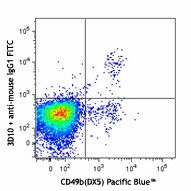
-

C57BL/6 mouse splenocytes were stained with CD49b (DX5) Pacific Blue™ and purified Ly49H (clone 3D10, top) or mouse IgG1, κ isotype control (bottom), followed by anti-mouse IgG1 FITC. -

| Cat # | Size | Price | Quantity Check Availability | Save | ||
|---|---|---|---|---|---|---|
| 144705 | 25 µg | 104 CHF | ||||
| 144706 | 100 µg | 221 CHF | ||||
Ly49H, also known as Cmv1 and Klra8, is a 28.3 kD protein. It is expressed on NK cells (but not on NKT cells) from C57BL/6 mice (but not Balb/c or DBA/2 mice). Expression of Ly49H has been associated with resistance to MCMV infection in C57BL/6 mice. Modulation of Ly49H expression by its antibody made MCMV-resistant C57BL/6 mice susceptible to infection. Unlike Ly49A, Ly49H lacks the ITIM (immunoreceptor tyrosine-based inhibitory motif) but has ITAM (immunoreceptor tyrosine-based activation motif), which is associated with DAP-12 (KARAP, killer cell activating motif).
Product DetailsProduct Details
- Verified Reactivity
- Mouse
- Antibody Type
- Monoclonal
- Host Species
- Mouse
- Immunogen
- C1498-Ly49A/H transfectant
- Formulation
- Phosphate-buffered solution, pH 7.2, containing 0.09% sodium azide.
- Preparation
- The antibody was purified by affinity chromatography and conjugated with PE under optimal conditions.
- Concentration
- 0.2 mg/ml
- Storage & Handling
- The antibody solution should be stored undiluted between 2°C and 8°C, and protected from prolonged exposure to light. Do not freeze.
- Application
-
FC - Quality tested
- Recommended Usage
-
Each lot of this antibody is quality control tested by immunofluorescent staining with flow cytometric analysis. For flow cytometric staining, the suggested use of this reagent is ≤0.25 µg per million cells in 100 µl volume. It is recommended that the reagent be titrated for optimal performance for each application.
- Excitation Laser
-
Blue Laser (488 nm)
Green Laser (532 nm)/Yellow-Green Laser (561 nm)
- Application Notes
-
Additional reported applications (for the relevant formats of this clone) include: immunoprecipation1, and in vitro2 and in vivo3 blocking activity. The Ultra-LEAF™ purified antibody (Endotoxin < 0.01 EU/µg, Azide-Free, 0.2 µm filtered) is recommended for functional assays (Cat. No. 144717 & 144718).
-
Application References
(PubMed link indicates BioLegend citation) -
- Guseva NV, et al. 2010. Eur. J. Immunol. 40:2618. (IP)
- Orr MT, et al. 2009. J. Exp. Med. 206:807. (Block)
- Rodriguez M, et al. 2004. J. Immunol. 173:6312. (Block)
- Product Citations
-
- RRID
-
AB_2561673 (BioLegend Cat. No. 144705)
AB_2561674 (BioLegend Cat. No. 144706)
Antigen Details
- Structure
- 28.3 kD
- Distribution
-
NK cells but not NKT cells
- Function
- Interacts with m157, a cytomegalovirus-encoded protein
- Ligand/Receptor
- m157
- Cell Type
- NK cells
- Biology Area
- Immunology, Innate Immunity
- Antigen References
-
1. Gosselin P, et al. 1999. J. Leuko. Bio. 66:165.
2. Lee SH, et al. 2001. Nat. Genet. 28:42.
3. Daniels KA, et al. 2001. J. Exp. Med. 194:29. - Gene ID
- 16639 View all products for this Gene ID
- UniProt
- View information about Ly49H on UniProt.org
Related Pages & Pathways
Pages
Related FAQs
- What type of PE do you use in your conjugates?
- We use R-PE in our conjugates.
Other Formats
View All Ly49H Reagents Request Custom Conjugation| Description | Clone | Applications |
|---|---|---|
| FITC anti-mouse Ly49H | 3D10 | FC |
| Purified anti-mouse Ly49H | 3D10 | FC,IP,Block |
| PE anti-mouse Ly49H | 3D10 | FC |
| Alexa Fluor® 647 anti-mouse Ly49H | 3D10 | FC |
| PE/Cyanine7 anti-mouse Ly49H | 3D10 | FC |
| APC anti-mouse Ly49H | 3D10 | FC |
| TotalSeq™-A0839 anti-mouse Ly49H | 3D10 | PG |
| Ultra-LEAF™ Purified anti-mouse Ly49H | 3D10 | FC,IP,Block |
| TotalSeq™-C0839 anti-mouse Ly49H | 3D10 | PG |
| TotalSeq™-B0839 anti-mouse Ly49H | 3D10 | PG |
Customers Also Purchased
Compare Data Across All Formats
This data display is provided for general comparisons between formats.
Your actual data may vary due to variations in samples, target cells, instruments and their settings, staining conditions, and other factors.
If you need assistance with selecting the best format contact our expert technical support team.
-
FITC anti-mouse Ly49H

C57BL/6 mouse splenocytes were stained with CD49b/DX5 Alexa... 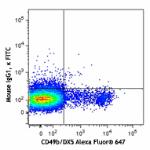
-
Purified anti-mouse Ly49H
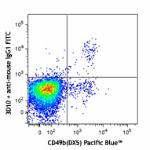
C57BL/6 mouse splenocytes were stained with CD49b (DX5) Paci... 
-
PE anti-mouse Ly49H

C57BL/6 mouse splenocytes were stained with CD49b (DX5) Paci... 
-
Alexa Fluor® 647 anti-mouse Ly49H
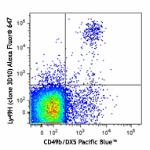
C57BL/6 mouse splenocytes were stained with CD49b/DX5 Pacif... 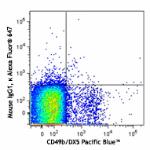
-
PE/Cyanine7 anti-mouse Ly49H

C57BL/6 mouse splenocytes were first treated with True-Stain... -
APC anti-mouse Ly49H

C57BL/6 mouse splenocytes were stained with CD49b (clone DX5... -
TotalSeq™-A0839 anti-mouse Ly49H
-
Ultra-LEAF™ Purified anti-mouse Ly49H

C57BL/6 mouse splenocytes were stained with CD49b (DX5) Paci... 
-
TotalSeq™-C0839 anti-mouse Ly49H
-
TotalSeq™-B0839 anti-mouse Ly49H
 Login / Register
Login / Register 









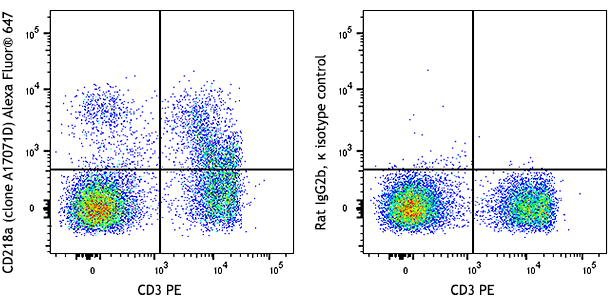

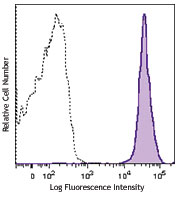




Follow Us